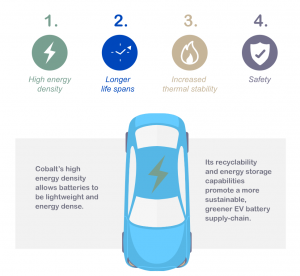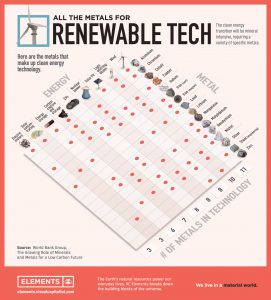The Cobalt Industry and Sustainable Equality
Written by: Erin Yoo
Its name comes from the “kobolds,” or underground sprites, that were believed to be the cause of poisonous fumes that German miners encountered while mining ore (The Chemistry, n.d.). Later, after miners and scientists realized that the magical creatures from local folklore were not the cause of dangerous gases, it was named cobalt. The twenty-seventh element in the periodic table is known for its blue tint, perhaps best known for the color “cobalt blue” (The Chemistry, n.d.; Frankel, 2016). However, cobalt has several other crucial functions for our world today, and although it’s thought to help advance humanity towards a greener future, the real impact of cobalt is more complex than that.
The Importance of Cobalt
These “kobold” rocks are essential for modern society. They’re mainly used in lithium-ion batteries which power everything from small smartphones and other mobile devices to electric vehicles. These powerful, long-lasting batteries are what make mobile devices mobile and electric vehicles durable (Batteries & Electric Vehicles, n.d.). Cobalt’s unique structural properties make it very durable and nearly irreplaceable in its various applications as seen in Figure 1 (The Chemistry, n.d.). With the rise of electric vehicles, which are far more eco-friendly than traditional petrol-run vehicles, the demand for cobalt is drastically increasing (Cobalt Use, n.d.). In fact, some countries are preparing to ban the sale of petrol cars as early as 2030 (Batteries & Electric Vehicles, n.d.).
Figure 1

Lithium-ion batteries which contain cobalt have numerous advantages over traditional lead-acid batteries
Source: The Cobalt Institute
Cobalt Mining
Cobalt is found in small concentrations in various geological settings such as sediment, hydrothermal and volcanogenic environments, the ocean floor, and of course, ore. It’s usually produced as a byproduct of nickel and copper mining (Types of Deposits, n.d.). In fact, 98% of cobalt is procured through this method, with the Democratic Republic of Congo being the largest producer (Cobalt Mining, n.d.). The U.S. is home to a few mining sites whose activities will likely increase in the next years do to rising demand for cobalt (Cobalt Mining, n.d.). Only a few places around the world, including Morocco and Canada, have extraction sites that are dedicated solely to cobalt since it is derived mostly from the mining of other minerals as mentioned previously (Cobalt Mining, n.d.).
The main entities that produce cobalt are part of the Cobalt Institute, but about 10-25% of global production comes from hand-miners in Congo who call themselves diggers, or “creuseurs” in French (Cobalt Mining, n.d.; Frankel, 2016). In Congo alone, they make up 17-40% of cobalt producers. Creuseurs work without industrial tools or maps, only manual tools such as shovels and hammers, and are not provided healthcare nor sufficient safety measures (Frankel, 2016).
Once cobalt is mined in Congo, it is sold to Congo DongFang International Mining, a company part of Zhejiang Huayou Cobalt, which is one of the largest cobalt producers in the world. From there, it is sold to battery producers, whose batteries then go to mobile tech and vehicle companies like Apple and Toyota (Frankel, 2016).
Environmental Effects of Cobalt Mining
All types of mining can be environmentally-dangerous because it’s necessary to burn fossil fuels to power mines, and many modern techniques have high water consumption. Of course, the very idea of mining itself is environmentally invasive. Furthermore, there are many opportunities for harmful substances from ore or other substances like polluted wastewater, to leak into the air, ground, and water (LePan, 2021).
With cobalt mining and increasing demand for other renewable tech metals like aluminum, copper, and silver, more mining is necessary as seen in Figure 2 (LePan, 2021). In fact, mineral demand would need to increase by 400% in order to reach the Paris Agreement goals by 2040 (LePan, 2021). These goals are to prevent the global temperature from increasing 1.5 degrees Celsius above pre-industrial global temperatures. Once global warming hits this benchmark, scientists believe climate change would be irreversible. This creates a paradoxical situation where it seems that environmental damage is needed for a greener future, and green energy is not cheap. Electric cars require six times more minerals than a conventional petrol car, and cobalt is the most expensive raw material in lithium-ion batteries (Frankel, 2016; LePan, 2021).
Figure 2

Metals required for renewable technology
Source: Visual Capitalist
Human Impact of Cobalt Mining
Environmental protection is not the only loss when it comes to cobalt mining. An estimated hundred thousand Congoan creuseurs, including children, face dangerous working conditions when mining cobalt out from hundreds of feet underground. Sometimes, they will dig under their own homes or wait until night to dig in land owned by private mining companies (Frankel, 2016). Due to little supervision and safety measures, such as a lack of prevention for cave-ins, injuries and death are common (Frankel, 2016). Another example is that rainwater fills mines during dangerous weather conditions, which creates possibilities of flooding and damage. Moreover, it’s not uncommon for creuseurs to sleep underground where toxic gases can build up.
After the cobalt is mined, women and children of the miners wash the dirt away from the mineral in rivers using sandbags. These same rivers are used for irrigation, cleaning, and fishing (Frankel, 2016). So, it’s not hard to imagine how easily the cobalt mining sector pollutes valuable water resources in Congo.
After washing, the creuseurs bring their cobalt to small shops known as “comptoirs” which are often owned by Asians as seen in Figure 3 (Frankel, 2016). In fact, on an investigative trip by the Washington Post, every comptoir they found was owned by Asians, although it is technically forbidden for foreigners to own comptoirs in Congo. Miners are paid for what they find, and on a good day, creuseurs will make $2-3.
Figure 3

An Asian man calculating the value of cobalt mined by creuseurs at a comptoir
Source: Washington Post
However, creuseurs are not the only ones to get the short end of the stick of cobalt mining. A study that analyzed soil in creuseur communities concluded that a region near a mine-heavy part of Congo was one of the ten worst polluted areas in the world (Frankel, 2016). Entire communities and villages around the mines face detrimental health effects by being exposed to toxic metals. Those effects can include breathing problems, birth defects, and death. One study discovered that the urine of adult residents near mines had cobalt concentrations forty-three times higher than the urine of a control group and lead levels five times higher (Frankel, 2016). For children, these numbers were worse. For instance, 53% of subjects had “markedly elevated” cobalt concentrations in their urine whereas this percentage rose to 87% in children (Banza et al., 2009).
Multiple cases of extremely rare birth defects like Mermaid syndrome and holoprosencephaly were reported in Congo near heavy-mining areas. In fact, holoprosencephaly, which is so rare that many doctors never come across it in their lifetime, was reported three times in three months (Frankel, 2016). Thus, as we’ve seen time and time again, environmental effects have the ability to impact human health along with the Earth, one of the most clear examples being the consequences of cobalt mining.
Conclusion
Although many, admittedly including myself, proclaim the importance of a sustainable future and greener initiatives, the reality is that sustainability is not always equitable. The benefits of producing electric vehicles, accessible smartphones, and more come with negative impacts even including environmental damage, even if some cases are only short-term.
The burden of dealing with the environmental damage and human impact often falls on those who do not reap the benefits. A creuseur and theirfamily in Congo is less likely to benefit from a Tesla than a middle-class American family. Conversely, that same middle-class American family is less likely to be harmed by the process of mining for the materials used to create Tesla batteries. They will not have to face exposure to toxic metals, dangerous mining conditions, and exploitation by foreign companies. There is no perfect solution, at least as of yet, for the inequities of environmentalism. Nevertheless, a good place to start is learning about these inequities and examining them as nuanced issues instead of blindly declaring a greener future.
References and Sources
Banza, C. L. N., Nawrot, T. S., Haufroid, V., Decrée, S., De Putter, T., Smolders, E., Ilunga Kabyla, B., Luboya, O. N., Ilunga, A. N., Mutombo, A. M., & Nemery, B. (2009). High human exposure to cobalt and other metals in Katanga, a mining area of the Democratic Republic of Congo. Environmental Research, 109(6), 745-52. https://doi.org/10.1016/j.envres.2009.04.012
Cobalt Institute. Batteries & Electric Vehicles. (n.d.). https://www.cobaltinstitute.org/essential-cobalt-2/powering-the-green-economy/batteries-electric-vehicles/
Cobalt Institute. The Chemistry. (n.d.). https://www.cobaltinstitute.org/about-cobalt/the-chemistry/
Cobalt Institute. Cobalt Mining. (n.d.). https://www.cobaltinstitute.org/about-cobalt/the-cobalt-value-chain/cobalt-mining/
Cobalt Institute. Cobalt Use. (n.d.). https://www.cobaltinstitute.org/about-cobalt/the-cobalt-value-chain/cobalt-use/
Cobalt Institute. Types of Deposits. (n.d.). https://www.cobaltinstitute.org/about-cobalt/types-of-deposits/
Frankel, T. C. (2016, September 30). The Cobalt Pipeline. Washington Post. https://www.washingtonpost.com/graphics/business/batteries/congo-cobalt-mining-for-lithium-ion-battery/
Kayembe, B. (2021, August 7). Electric Cars And Cobalt Mining. Public Policy Africa. https://www.publicpolicyafrica.org/op-ed-articles/electric-cars-and-cobalt-mining-the-environmental-sustainability-of-the-privileged
LePan, N. (2021, May 27). Visualizing All the Metals for Renewable Tech. Visual Capitalist. https://elements.visualcapitalist.com/all-the-metals-for-renewable-tech/?utm_source=newsletter&utm_medium=email&utm_campaign=greenfin&utm_content=2021-06-09&mkt_tok=MjExLU5KWS0xNjUAAAF9j9g1kitkFPFuUoI1FdYJ0uB7SfxrOgXTA48qsiu60uZKc8ISWOJDxNwJyjBCeOUNmF7h_lLSuLkdOuBxdP_i_-Ft8-58XOit-HsomtsqnvVwJWs